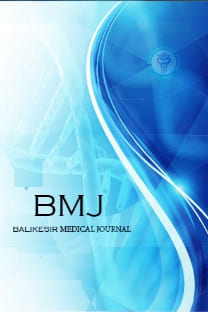Distomolar Diş Kaynaklı Görülen Perikoronitis: Bir Olgu Sunumu
distomolar diş, perikoronitis, periodontoloji, distomolar tooth, pericoronitis, periodontology
Pericoronitis Caused by Distomolar Teeth: A Case Report
distomolar tooth, pericoronitis, periodontology,
___
- Kaynaklar
- 1-) Scheiner MA, Sampson WJ. Supernumerary teeth: A review of the literature and four case reports. Aust Dent J 1991; 42: 160- 5.
- 2-) Gündüz K, Çelenk P. Distomolarlar üzerine retrospektif bir çalışma. Türkiye Klinikleri J Dent Sci 2006; 12: 83-6.
- 3-) Yusof WZ. Non-sydrome multiple supernumerary teeth: literature review. J Can Dent Assoc. 1990: 56; 147-9.
- 4-) Zengin ZA, Sümer AP, Çelenk P. Bilateral ve unilateral beşinci molarlar: iki olgu sunumu SÜ Dişhek Fak Der 2008; 17: 54-7.
- 5-) Mittelman HR, Poliak M. Fourth molars in the maxilla and mandible. Exodontia.1963; 16: 1297- 1300.
- 6-) White SC, Pharoah MJ. Oral Radiology Principles and İnterpretation 4 th Ed. C.V.Mosby Co. St Louis.2000, p.303.
- 7-) Grimanis GA, Kyriakides AT, Spyropoulos ND. A survey on supernumerary molars. Quintessence Int 1991; 22: 989-95.
- 8-) Bereket C, Özkan ÇN, Şener D ve ark. Sürnümerer molar dişlerin retrospektif olarak incelenmesi klinik ve radyolojik bir çalışma. Atatürk Üniv. Dis Hek. Fak. Derg. 2010; 20: 176-80.
- 9-) Sugimura M, Tsuji Y, Yamaguchi K ve ark: Mandibular distomolars. Oral Surg. 40: 341-345. 1975.
- 10-) Piattelli. Tete S: Bilateral maxillary and mandibular fourth molars. Report of a case. Acta Stomatologica Belgica 89: 57-60. 1992.
- 11-) Neville B, Damm D, Allen C ve ark. Oral Maxillofacial Pathology. 2.nd Ed. WB Saunders, Philadelphia.2002, p.71.
- 12-)Mollaoğlu N, Güngör K. Süpernümerer dişler: literatür derlemesi ve olgu bildirimleri. Atatürk Üniv Diş Hek Fak Derg 2000;10:40-44.
- 13-) Timocin N, Yalcin S, Ozgen M ve ark. Supernumerary molars and paramolars. J Nihon Univ Sch Dent. 1994 ;36(2):145-150.
- 14-) Arslan A, Altundal H, Ozel E. The frequency of distomolar teeth in a population of urban Turkish adults: a retrospective study. Oral Radiol. 2009; 25: 118-22.
- 15-) Açıkgöz A, Açıkgöz G, Tunga U ve ark. Characteristics and prevalence of non- syndrome multiple supernumeraries: A retrospective study. Dentomaxillofac Radiol. 2006; 35: 185-90.
- 16-) Orhan IA, Özer L, Orhan K. Familial occurence of nonsyndromal multiple supernumerary teeth. Angle Orthod. 2006; 76: 891-7.
- Yayın Aralığı: Yıllık
- Başlangıç: 2017
- Yayıncı: Balıkesir Üniversitesi
ICD İmplantasyonu Sonrası Görülen Nadir Komplikasyon: Cilt Nekrozu
Abdullah Orhan DEMİRTAŞ, Eyup Avcı, Didar Elif AKGÜN
Sezaryen skar gebeliğin laparoskopik tedavisi: Olgu Sunumu
Akın Usta, Dilay Karademir, Banu Güleç Başer, Ertan Adalı
Tek Kaburga Kırığına Bağlı Akciğer Herniasyonu
Nadir Görülen Komplikasyonsuz Dev Plasental Koryoanjioma: Olgu Sunumu
Dilay KARADEMİR, Akın USTA, Eren ALTUN, Selçuk YAZICI, Ertan ADALI
Distomolar Diş Kaynaklı Görülen Perikoronitis: Bir Olgu Sunumu
Melike ÖZTÜRK, Fatih KARAASLAN, Recep ORBAK, Mithat TERZİ
Bronşektazili bir hastada gelişen Pasteurella canis pnömonisi
Özlem AYDEMİR, Kerem YILMAZ, Yusuf Aydemir AYDEMİR, Tayfur DEMİRAY, Mehmet KÖROĞLU, Mustafa ALTINDİŞ
Yetersiz İnteroklüzal Mesafenin Kemik Kaldırılmaksızın Düzeltilmesi
Balıkesir Bölgesinde Ailesel Akdeniz Ateşi Ön tanısı Alan Hastalarda MEFV Mutasyon Sıklığı
